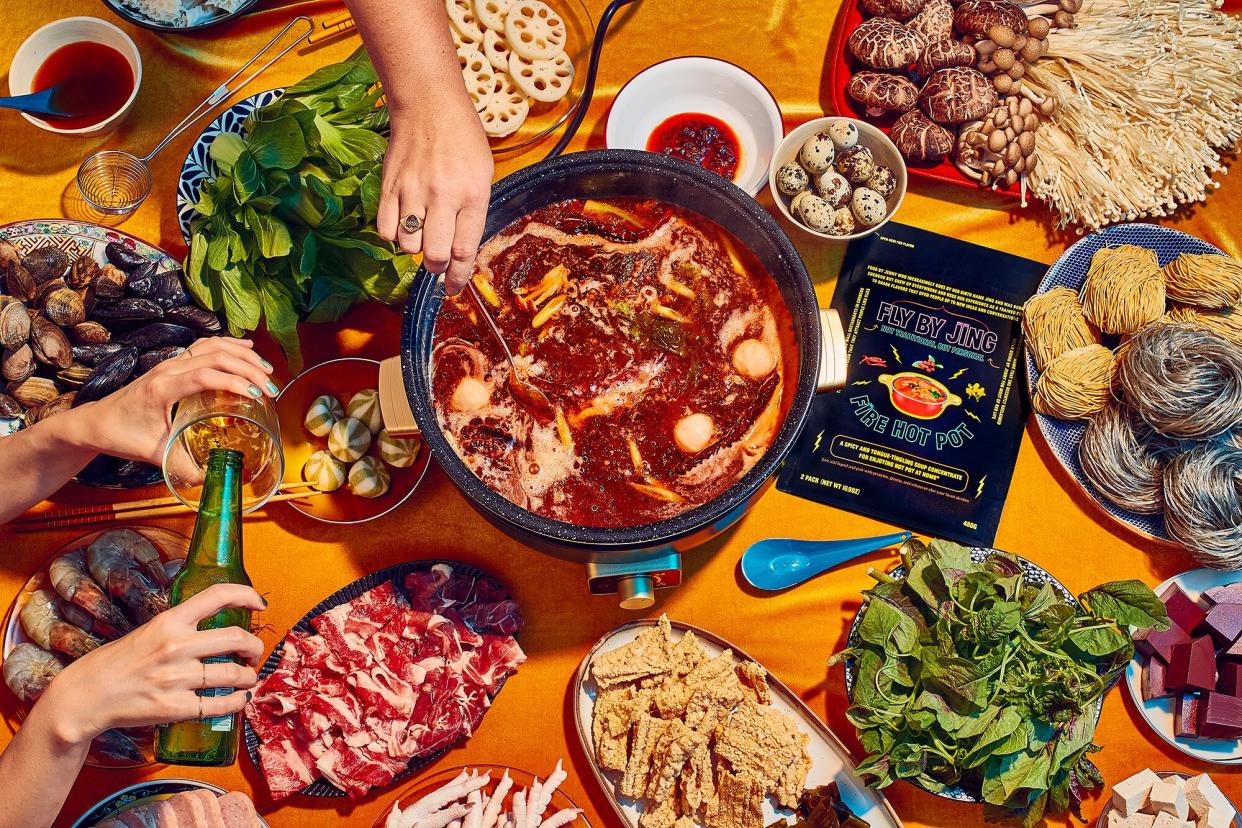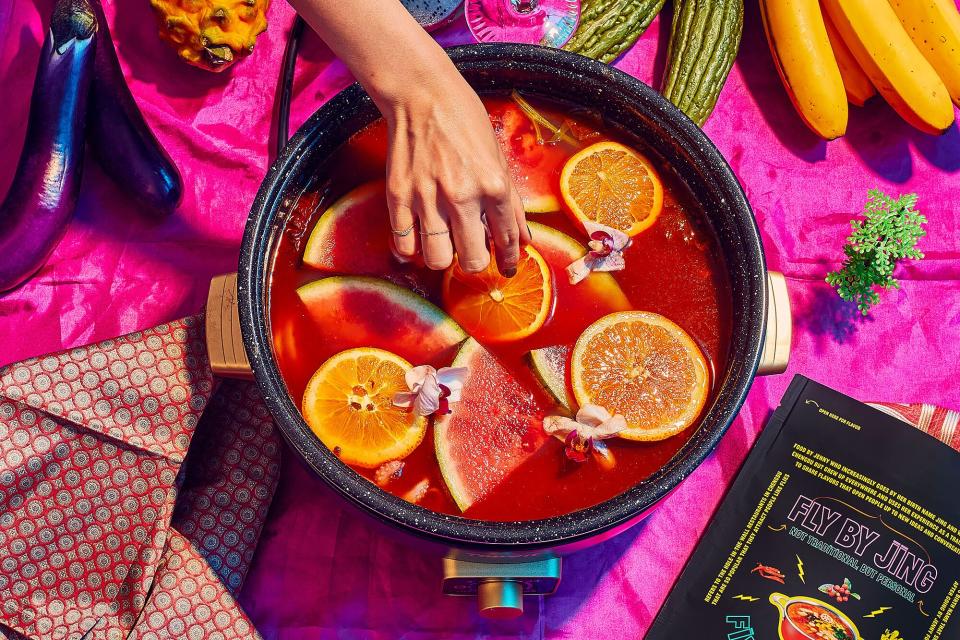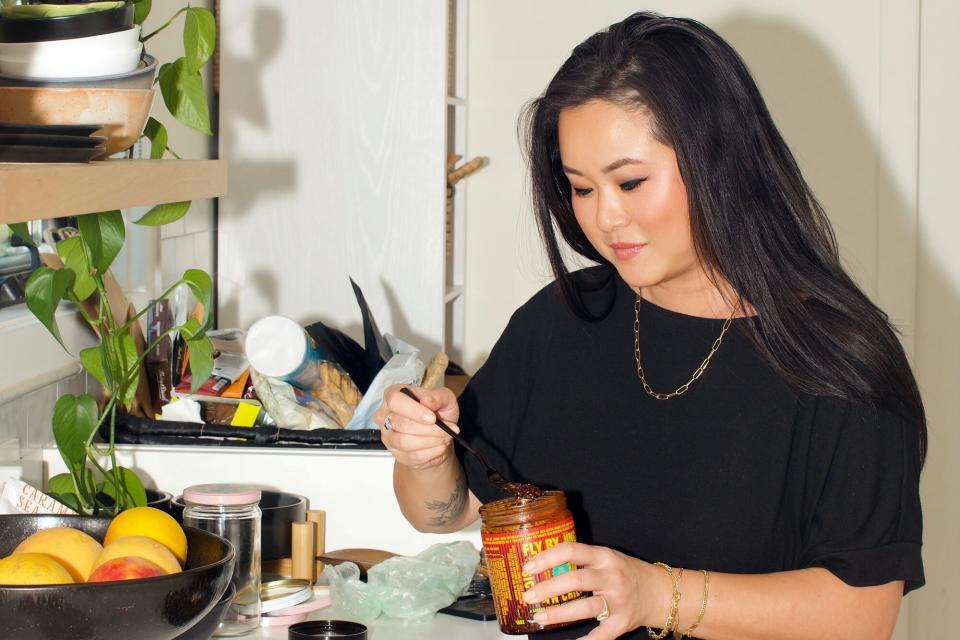What We Are Still Getting Wrong About Chinese Food

Courtesy of Fly By Jing
Chances are you've heard of chili crisp, the Chinese condiment that exploded into American home kitchens when pandemic-weary cooks were looking for new ways to add flavor to their food. My all-natural Sichuan Chili Crisp is what put my condiment company Fly by Jing on the map, but my ambitions for the brand have always been greater: To shine light on this 5,000-year-old culinary heritage, and rewrite false narratives about Chinese food that have existed for centuries in the West. If the goal is to shift culture, then Fly By Jing's vehicle for change is flavor.
It was flavor that brought me back to my hometown, Chengdu. I spent most of my childhood moving across Europe and Canada, but one thing that remained consistent was the understanding that my family and I were different. In an attempt to blend in as a kid, I adopted the name Jenny, which stuck for most of my life, until last year when I finally found the conviction to reclaim my birth name, Jing.

Courtesy of Fly By Jing
When I moved to China for a tech job in my twenties, I was swept up in the food and flavors of my native country. Food became the primary path for reconnection with my Chinese roots, and the more I uncovered the rich layers of China's diverse regional cuisines, the more I learned about myself. I quit my high-flying job in tech and threw myself into the study of regional Chinese cuisines and flavor profiles, eventually opening a restaurant called Baoism in Shanghai, and an underground supper club called Fly By Jing, inspired by the flavors of Chengdu's "fly restaurants"—small eateries so good they attract people like flies. I wasn't just reconnecting with myself, but with family—like my grandparents, who I stayed with while developing the first iterations of the chili sauces and condiments that I would later bring to the US.
RELATED: F&W Game Changers: Next-Gen Flavor
Chinese food sits at curious intersections in the West. It is both completely ubiquitous and exotified beyond recognition. It's expected to fit into everyone's individual ideals of "authenticity," formed by vastly differing experiences from person to person. Invariably, it has to be cheap.
This pursuit of "authenticity" by the Western gaze has created a false ownership over the narrative of what Chinese food is and isn't, and in turn, extending to what Chinese culture—and, importantly, its people—can and cannot be. In my journey to building the first premium, all-natural Chinese food brand in the US, I've met resistance every step of the way, in the form of everything from unconscious biases to rampant prejudices, and I feel it's worth breaking down just how we arrived at some of these commonly-held beliefs. The following is a closer examination of just a few things we're still getting wrong about Chinese food.
"Chinese Food will never be accepted by the mainstream."
When I first visited Expo West, the largest natural food expo in the US, back in 2018, I was shocked to see little to no Chinese flavors present. How could it be, I thought, when this food was so popular across the country? For context, there are more Chinese restaurants in the United States than every single McDonalds, Burger King, KFC, Taco Bell, and Starbucks combined. It seemed to me that rather than a Big Mac, the most quintessentially "American" food in America might just be a bowl of chow mein or orange chicken.
That same year, I launched our best-selling hot sauce Sichuan Chili Crisp on Kickstarter, where it broke records as one of the highest-funded craft food projects ever on the platform. Clearly there was an appetite for high-quality Chinese flavors unadulterated by artificial additives and preservatives.Despite that success, I quickly realized that others did not agree. As I worked to get Fly By Jing off the ground as a boot-strapped founder, I met many investors (many of them white) who dismissed my early traction as a fluke, saying "Chinese food is niche, it will never cross over to the mainstream." Meanwhile, New York Times recipes with eyebrow-raising titles like "The Dish That Will Make You Fall in Love With Chinese Food" implied that the majority of people did not find Chinese food appealing.
RELATED: 6 Spicy Condiments You Should Be Using All Season
I was forced to build the company without any outside funding, but being capital-constrained forced me to be creative with resources.We went on to grow 1000% in our second year as a direct-to-consumer online brand, became the top-selling hot sauce on Amazon, and are about to launch in brick and mortar stores at Whole Foods, Target, Costco and more. Despite what those investors might have thought, these days, it's hard to flip through any leading food magazine without finding a recipe that calls for chili crisp, and I have a feeling this won't change anytime soon.

Courtesy of Fly By Jing
"Authentic Chinese food is supposed to be cheap."
When I moved to the US and started selling my Sichuan Chili Crisp, the small-batch condiment I created in the kitchen of my supperclub in Shanghai, the response to the product was immediate. Most people who tried it loved it. But for every supporter there were hundreds of others who saw our ads online and swiftly discredited it in comments on social media like: "$15 for a jar of chili sauce?? Why so expensive?" "I could get this for $2 at my local Chinese supermarket!" " What a ripoff."
At first I responded with lengthy explanations of the premium and rare ingredients I spent years sourcing in China, the laborious technique involved in crafting the sauce, not to mention the obvious incongruity of comparing a product made by a bootstrapped startup to those of multinational corporations with economies of scale. But then I got curious.
What was it that made people believe Chinese food was devoid of value? That the people dedicated to the craft and heritage of their cuisine didn't deserve to profit from their labor? It's worth noting that the same criticisms are rarely directed at white chefs creating "elevated" versions of dishes they claim to have discovered in their travels East.
RELATED: Hot Sauce Marketing Is So Aggro, But the Community Behind It Is Surprisingly Sweet
I first read about the "Hierarchy of Taste" in a book called The Ethnic Restaurateur by NYU Food Studies Professor Krishnendu Ray. In it, he lays forth a comprehensive theory on why some cuisines command a higher price than others. Carne asada and steak frites are an example of a similarly high-quality cut of meat that are listed at vastly different prices, as are ravioli and dumplings, pasta and hand-pulled Lanzhou noodles. Ray puts forth that this hierarchy is shaped by a simple rule: the value we place on a cuisine is informed by our perception of the socio-economic status of emigrants from those countries. "With China, [Americans] are still filled with this funny disdain, that it is about cheap and crappy stuff, including cheap and crappy food," he says.
Chinese food proliferated in America directly as a result of the Chinese Exclusion Act in 1882— the first law to ban the immigration of a group of people solely based on race. But because of a loophole that allowed merchants to operate restaurants, Chinese food spread like wildfire across the country. To attract diners, prices were kept low, which made Chinese food an affordable luxury that helped democratize the experience of dining out. What made this possible was the exploitation of these underpaid and overworked laborers, which in turn is what made it so popular. Dark origins, indeed. This is a cuisine born from resilience in the face of racism and xenophobia, and the expectation of Chinese food as cheap is a paradigm that we have existed within ever since. It is the reason that in 2018, I still wasn't able to find any premium Chinese food on grocery shelves. Real food, real ingredients, ethical sourcing and manufacturing comes at a cost. Our food, our culture, and our people have value, and it's about time our compensation reflects that.

Courtesy of Fly By Jing
"My experience with Chinese food is the ONLY experience."
It's no surprise that our exposure to Chinese food, or any "ethnic" food for that matter, has been limited and filtered through an oversimplified lens. Food media has been particularly guilty here, from tokenizing to white-washing in coverage, which led to a reckoning at several large publications over the past years. I've personally been told by editors and publishers that "Asian cookbooks don't sell," or "We've already written about one Asian brand in this issue of the magazine, so we can't cover another." This approach has led my company to lose out on growth opportunities, and fellow small businesses in the Asian food space are pitted against each other even when operating in entirely different spaces.
Some of Fly By Jing's most frequently received comments online are "What's the difference between this and Laoganma?"and, "Is this just some hipster, marked-up version of Laoganma?" The presumptions being that: a) there must only be one brand of Chinese sauce on the market, b) all chili oil is the same, and c) because of one's proximity to Chinese culture (i.e. "I've been to Chinatown" or the ever-trusty "My girlfriend is Chinese"), one's own narrow experiences must now hold true for everyone else.
RELATED: Chinatown Needs Your Love More Than Ever Right Now
The truth is that there are thousands of different styles of chili oil in China, with every family safeguarding their own recipe. I've seen ingredients ranging from nuts and seeds to beef jerky, mushrooms, and fermented fava beans. The idea that there's a one-size-fits-all chili oil is both reductive and unimaginative.
But it's easy to be reductive when our exposure to others has been so limited. There is no room for complexity if everything is binary. Like its people, Chinese flavors are far more complex, ever-evolving, and diverse than that. We are more than that. What started as my personal quest to reconnect with my roots has become a mission to celebrate the many-layered stories of the diaspora, because real stories are personal, and they deserve to be told.
Fly By Jing is the product of a personal journey of discovery and coming home to self. Like me, it's born in Chengdu, but living in America. It's rooted in tradition, but made for the way we live today. It doesn't conform to anyone else's notions of value, taste, or tradition. It's one person's recipes, one person's vision, and one person's story.
And with these flavors, I'm telling you mine.

